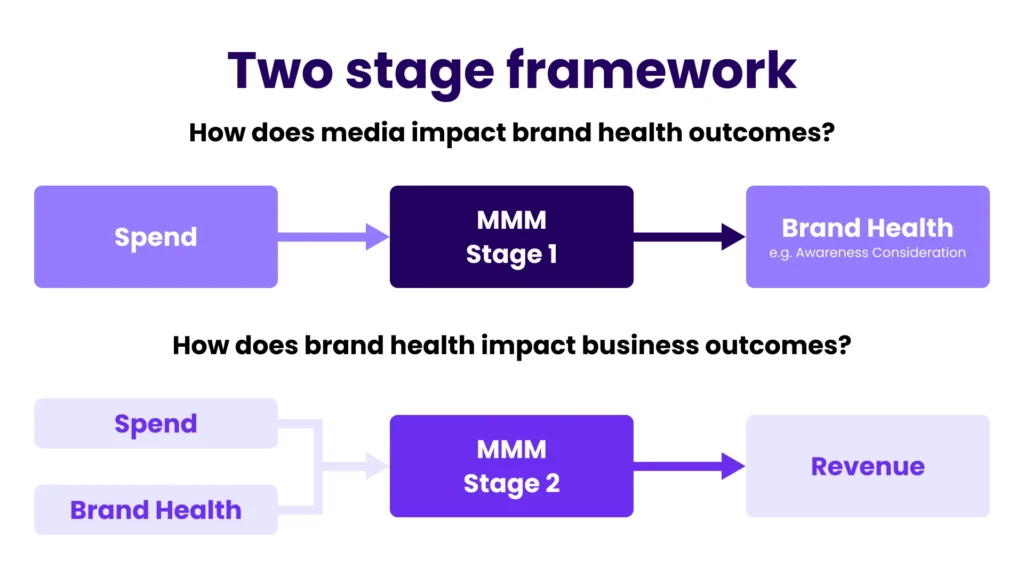Brand Equity and Its Impact on Revenue


It has long been common for marketers to have separate media buying budgets for branding efforts and performance-driving efforts, with each living on their own proverbial side of the house. Branding budgets have historically had their own set of KPIs, different from those tracked and measured for performance marketing initiatives, with the dichotomy implying that one has no influence on the other.
But we all know brand and performance don’t live in vacuums.
For example, even the most sophisticated, omnichannel marketing campaign isn’t likely to drive sales for a product if the manufacturer of that product is making headlines for safety concerns or quality control issues. The problem hasn’t been that marketers don’t believe the two impact one another, rather that they had no measurable way to show it.
Unable to meaningfully tie brand-driven effects to performance outcomes has left marketers relegated to basic metrics like reach and frequency. This puts more pressure on performance dollars to improve metrics including ROAS (return on ad spend), CAC (customer acquisition cost), and CPAs (cost per acquisition).
We hypothesize that brand heavily influences performance and have identified a streamlined way to more effectively measure it on an ongoing basis. Failing to account for brand equity leaves marketers underestimating the total value of their campaigns, missing a fundamental driver of both ROAS and their bottomline business.
At Tinuiti, we think of brand equity as the cumulative set of widely held perceptions, incorporating both the value propositions of your product itself, and the positive and negative sentiments about your brand as a whole. These perceptions can significantly influence consumer behavior, and through that behavior, influence revenue over time.
Example scenario:
Imagine you own and operate a popular coffee shop in your neighborhood and have built a great reputation that earns you a lot of word-of-mouth business. Despite your success, you decide to close your coffee shop for a few years so you can travel the world.
Fast-forward a few years and you’re set to reopen, but have decided to go with a totally new name for your shop. Do you think you would receive the same response from the market immediately, as though you’d never left and nothing had changed? We don’t believe so.
Trust is a key ingredient of a strong brand, and just as in other aspects of life, trust is slow to build and can be lost very quickly. However, the promise of your brand could be rebuilt over time to help eventually get back to where you started.
Brand equity is slow to build but has long-lasting effects on consumers, while brand health can have a significant impact on the revenue you’re driving today. Furthermore—business outcomes, such as revenue—have traditionally been attributed to performance marketing…but this relationship is incomplete.
We believe brand equity is a key missing piece in the equation that gets us closer to accurate attribution of business outcomes.
As marketers, there is a hidden set of variables we all struggle to measure, understand, and leverage to our benefit as they relate to the slowly-won equity of a brand, with the terms “brand equity” and “brand health” often being used interchangeably. However, we think of brand equity as a broader umbrella term that represents the intangible value of a brand, while brand health is more closely associated with the immediate perception of a brand at a particular point in time.
As a performance marketing firm, accurate measurement and attribution is key for our teams. However, as we explored above, performance marketing alone paints an incomplete picture.
In our quest to better understand all revenue-driving aspects of a given campaign, we have started on a process to quantify the impact of Brand Equity, which we believe is one of the largest missing pieces in more accurate and complete measurement.
To do so, we are looking at Brand Health in the modeling and analysis phase as it reflects Brand Equity at a given point in time, is measurable in real-time, and can be tied to business outcomes such as revenue.
Ultimately, we hope our research will help us answer important Marketing questions like:
These complex questions can be distilled into 2 essential questions:
We are currently developing a robust quantitative framework to answer these two essential questions. While randomized control trials are the gold standard for causal inference, brand-building is a slow process, and running these experiments can be both time-consuming and expensive.
Media Mix Modeling (MMM) provides a neat alternative to this problem by leveraging observational data. We chose Meta’s open-source MMM tool, Robyn, for our framework, thanks to its sophistication and ease of use.

While brand and performance marketing investments are often managed and measured separately, we believe that they have a significant impact on each other. We believe the impact of brand equity on revenue to be supplementary, and this crucial element is often overlooked by marketers when estimating ROAS.
Tinuiti will be working with Meta in 2024 to provide a deeper dive into our collaborative efforts supporting brand health measurement. Stay tuned!
This article was a collaborative effort, with contributions from additional individuals, including Shannon Mullery, Senior Content Specialist, Marketing at Tinuiti, Kevin O’Connor, Manager, Econometrics at Tinuiti, Kolin Kleveno, SVP, Partnerships at Tinuiti and Ravi Rajan, Econometrics Director.